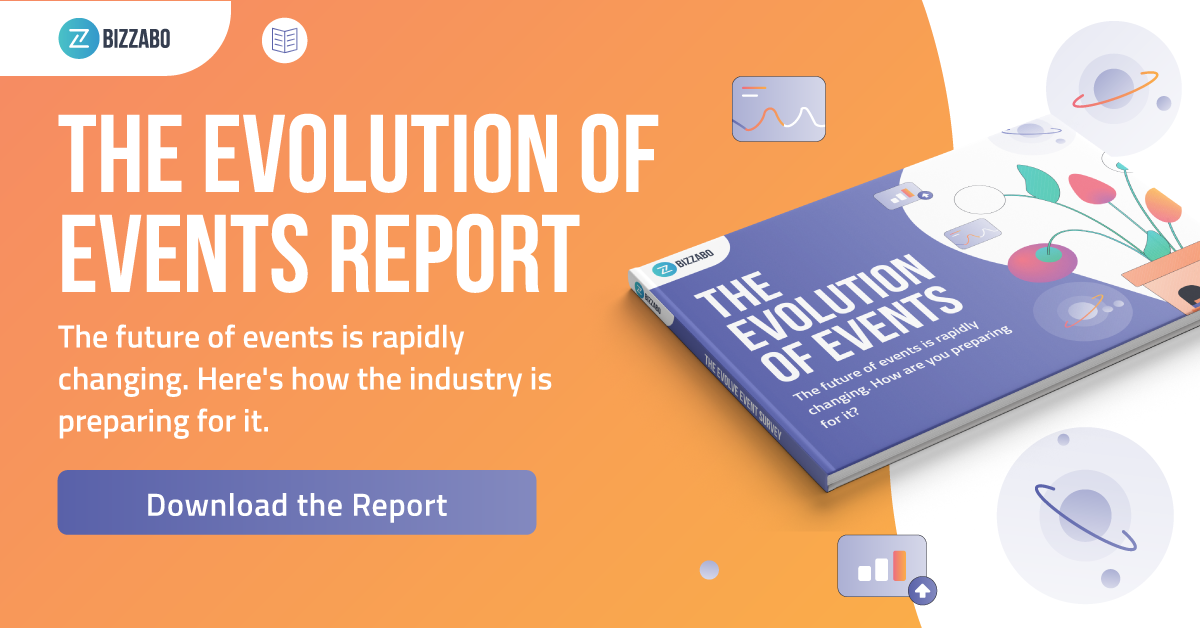Bizzabo’s Virtual Event Solution powered thousands of events this year. Here are the virtual event benchmarks we found from analyzing our proprietary data.
2020 has been a year for trial and error as event marketers continue to navigate and perfect virtual events. We’ve seen an impressive amount of innovation from event planners, from virtual event strategies to virtual event production, and virtual event tools that help event marketers create meaningful experiences. We also expect hybrid events to be a major player next year, combining the best of in-person and virtual experiences.
As we near the end of the year, Bizzabo has seen the tremendous growth of virtual events first-hand. When we first released these benchmarks, we had 210 virtual events to analyze. This time, we’re compiling data from 1,850 virtual events that took place between July 1, 2020, and October 31, 2020. This explosion of virtual events tells us these industry stats will be invaluable to organizers as they plan virtual events in 2021.
1. 80% of virtual event registrations are free.
As we discovered in our Evolution of Events Report, greater audience reach was the top benefit that organizers have seen from the shift to virtual events. One reason might be a lower cost barrier of entry. Between March and June, 80% of virtual event registrations were free, and remarkably, that number has stayed consistent throughout the year.
While many events have been free, that doesn’t necessarily mean that paid virtual events are getting any cheaper. In fact, paid virtual registrations create ample opportunities for event planners to create innovative pricing models for their virtual experiences.

2. The average price for a paid virtual event in Q3 & Q4 2020 was $443.
The average price for a paid virtual event in the last 6 months of 2020 was $443, compared to $378 in Q2 2020. While the averages aren’t so far apart, each month has shown a significant ebb and flow, dipping to $254 in June and rising to $629 in July.

The changing trend of virtual event ticket pricing over the past year suggests that event marketers are continuing to test the balance between larger audience reach and event revenue. We will continue to follow the average virtual event ticket price month over month to see how it evolves.
3. 50% of registrants convert to virtual event attendees.
We’re seeing a high average event conversion rate (50%) from those who registered to those who actually attended virtual events in Q3 2020 and Q4 2020. However, this number is down from 54% the last time we released these stats in June. There was also a change in average event length and sessions – which we’ll dive into below – that might be related to this drop. Overall, this is still a surprisingly positive show-up rate given that 80% of registrations are free.
4. Attendees are engaged for 53% of virtual sessions.
While this stat is down from 68% in Q2 2020, it’s still a promising number that suggests remote audiences are eager to engage in virtual experiences. According to our Evolution of Events Report, engagement and networking are still the top challenges that organizers face in the virtual world.

From our data, we also found that attendees watched 61% of 60-minute sessions. When you account for virtual fatigue, work-from-home distractions, and general attendance drop-off, it’s great to see people engaging with this much of the content.
While this is an impressive stat, event planners are always looking for more ways to engage their virtual attendees. At our recent virtual summit: (Almost) HYBRID, Leon Winkler (Director of International Events at Ubisoft) shared his advice for engaging online audiences that he draws from his experience in the gaming industry:
“Content is king…focus on content that is relevant to your audience…You need to have content that captivates the attention of whoever is watching. Then on top of that, you need to create something that is engaging and creates dialogue. It has to be more than passive watching.”
– Leon Winkler, Ubisoft
5. The average number of sessions per virtual event is 20.
This is up slightly from the 18 average sessions we saw organizers programming for their events in Q2 2020.
The increase might be the result of event organizers planning many shorter sessions, rather than a few long ones. Virtual events provide a unique opportunity to diversify the type of sessions and event types—including live-streamed keynotes, virtual networking lounges, and pre-recorded entertainment segments. This allows event organizers to explore a variety of sessions during one virtual event.
6. 58% of virtual sessions are smaller and more interactive.
From July to December, over half (58%) of virtual sessions still relied heavily on an interactive environment allowing attendees to go “on stage” and participate. These sessions tend to be smaller and more intimate, capping at 300 live attendees.

Larger sessions that broadcast in a keynote format make up a smaller percentage (16%) of event sessions. Event marketers leverage large keynote sessions because they can stream live to tens of thousands of attendees. These broadcast level virtual sessions limit interaction between the stage and attendees to text-based activities like a live Q&A or polling.
We’re also seeing a small percentage (6%) of event marketers taking advantage of the variety of video players available by embedding external video players—like YouTube and Vimeo—into the session home of their virtual event. This allows for more flexibility when determining which video player to use when streaming live or on-demand sessions.
7. 57% of virtual events are a single-day event.
Over half of all virtual events are single-day events. This stat is down only 3% from 60% in Q2 2020. Considering that the average virtual event now features 20 sessions, it appears many organizers are investing in multiple and/or concurrent sessions. In addition, we’re seeing two-day virtual events comprising the second largest percentage (14%) of virtual events followed by three-day events (9%).

8. The average event has 14 sponsors.
Securing sponsors has always been a challenge for event planners, and it’s no different in the virtual world. According to our Evolution of Events Report, marketers report an average Confidence of 6.5 in driving value for sponsors.

For more information and helpful insights check out our Event Sponsorship Guide.
In the last 6 months, event organizers have secured an average of 14 sponsors for each event. Winning event sponsorship, is all about driving value for your potential sponsors. Adele Durham has some great advice for creating those experiences that sponsors want to be a part of.
“I think it’s important to realize the context around these events. What has rung true in the last four or five years is that sponsors want to partner with us on an activation that is close to their hearts. Whether they want to do something that is philanthropic or whether they want to do something that’s for thought leadership or purposeful, you really have to hone in on what they want to get out of the experience rather than just putting their logo on a step and repeat.”
– Adele Durham, VP Events, Haymarket Media
9. Conferences are the most popular Virtual Event Type.
Virtual Conferences account for 43% of all digital events run on the Bizzabo platform.

The second most popular event type is Meeting & Networking, making up 23% of virtual events. Networking is one of the main things attendees ask for in events and going virtual hasn’t changed that. Event organizers are looking for ways to create networking opportunities for their audience in the virtual world.
There are multiple ways to facilitate connection at your virtual event, like setting up roundtable discussions based on similar interests or creating slack groups where attendees can network with their industry peers. At (Almost) HYBRID, we created a dedicated slack channel for our audience to chat and spark conversation.
Internal events are also being held online, accounting for 13% of virtual event types. Internal events are a great format to hold online because they are likely more intimate, so you can take advantage of interactive features such as Q&A or live polls.
10. 80% of Organizers enable on-demand for virtual sessions.
An overwhelming majority of event planners (80%) who hosted virtual events also enabled on-demand access for at least one of their sessions. On-demand is a great way to reach a larger audience. It allows attendees in different locations and time zones to engage with your content on their own time. You can also give attendees who may be busy at the live event time the chance to catch-up when they can. On-demand sessions also make your content evergreen, so folks can revisit the session anytime, whether they just want to listen again or are looking for something specific they may have heard during the live session.
Wrapping Up: Embracing Virtual Events
Virtual events are breaking down the barriers of place, cost, and time by offering a digital venue for anyone to connect, free registrations, and on-demand content that attendees around the world can access. The challenge for event organizers is balancing the right registration experience, technology, event type, and sessions to bring people together in powerful and impactful ways.
Looking for more insights? Check out our Evolution of Events Report to discover how senior event marketing professionals are planning for the future of events.
Click here to see original post


